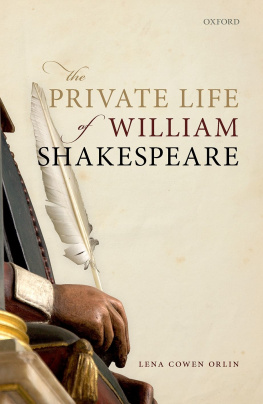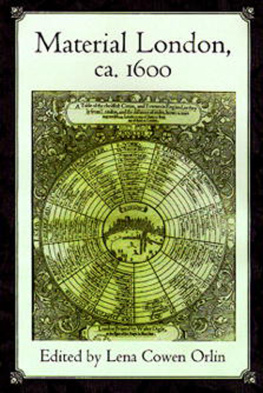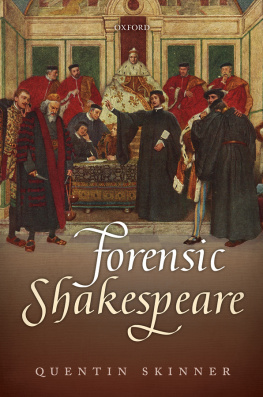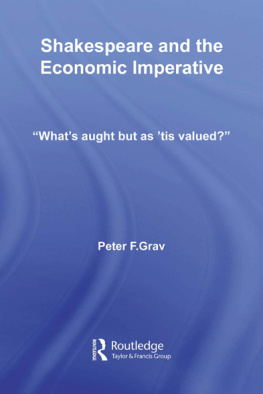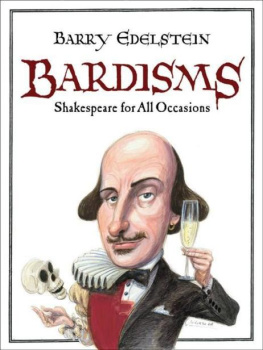The Private Life of William Shakespeare

Great Clarendon Street, Oxford, OX2 6DP, United Kingdom
Oxford University Press is a department of the University of Oxford. It furthers the Universitys objective of excellence in research, scholarship, and education by publishing worldwide. Oxford is a registered trade mark of Oxford University Press in the UK and in certain other countries
Lena Cowen Orlin 2021
The moral rights of the author have been asserted
First Edition published in 2021
Impression: 1
All rights reserved. No part of this publication may be reproduced, stored in a retrieval system, or transmitted, in any form or by any means, without the prior permission in writing of Oxford University Press, or as expressly permitted by law, by licence or under terms agreed with the appropriate reprographics rights organization. Enquiries concerning reproduction outside the scope of the above should be sent to the Rights Department, Oxford University Press, at the address above
You must not circulate this work in any other form and you must impose this same condition on any acquirer
Published in the United States of America by Oxford University Press
198 Madison Avenue, New York, NY 10016, United States of America
British Library Cataloguing in Publication Data
Data available
Library of Congress Control Number: 2021941198
ISBN 9780192846303
ebook ISBN 9780192661418
Printed and bound in Great Britain by
Clays Ltd, Elcograf S.p.A.
Links to third party websites are provided by Oxford in good faith and for information only. Oxford disclaims any responsibility for the materials contained in any third party website referenced in this work.
To my brothers Larry and Perry
Contents
The date of Shakespeares birth is unknown. It was an event that took place off the institutional roster, perhaps in his parents house in Stratford-upon-Avon. Family papers might have logged the day, and even, for astrological purposes, the time. These, if they once existed, have not survived. Our first notice of Shakespeare is his entrance into the public record via the parish church, which was charged to keep account of all baptisms, weddings, and burials. As enrolled in the Stratford register, Gulielmus filius Johannes Shakspere was christened on 26 April 1564.
Also in the register is the burial date 25 April 1616. According to his funerary monument, Shakespeare had died two days before: Obiit anno domini 1616, tatis 53 die 23 Aprilis. Earlier antiquarians must have calculated that Shakespeare would not have achieved his fifty-third year on 23 April 1616 had he not been born on 23 April 1564or so the editor Edmond Malone would come to reason. Malone may or may not have been right. William Oldys, compiling information for a biography, seems to have read the memorial inscription to mean that Shakespeare was born on 23 April 1563, and his election of the day lingered in influence despite his error in the year. It is unclear why Stratford schoolmaster Joseph Greene wrote Born on the 23d next to his transcription of the baptismal entry on the 26th. Some assumed that Greene recorded local tradition. George Steevens, who had access to the notes of both Oldys and Greene, did not question their methods. In a 1773 edition of Shakespeares plays, Steevens made it a matter of fact that he was born April 23, 1564.
It was the feast day of Englands patron saint, St George. The twin felicities of destiny and symmetry have proved irresistible to biographers ever since. If for Malone the funerary monument was the only authority remaining, later authors rose to the challenge of finding further substantiation for so auspicious an accident of the calendar. In 1848, James Orchard Halliwell-Phillipps observed that two of John Dees four children had been christened three days after birth. Three days was often the period which elapsed between birth and baptism, he declared, and those who came after him, counting back from Shakespeares 26 April baptism to a 23 April birth, called the three-day interval common practice. In 1904, Charles Isaac Elton advised that we should go by the rule in the Prayer-book. The 1559 Book of Common Prayer enjoined that public baptism, in church, should not be ministered but upon Sundays and other holy days, and that private baptism, at home, must not be deferred any longer than the Sunday or other holy day next after the child be born. Since Shakespeare was not baptized on 23 April, which was a Sunday in 1564, it follows that he cannot have been born earlier than 23 April. Elton disposed of the inconvenient fact that the next holy day after 23 April was 25 April, dedicated to St Mark, by suggesting that the christening would have been delayed until 26 April because St Marks Day was known to be unlucky. It had been only six years since the reign of Mary I, he pointed out, when crosses and altars were probably again draped in black as they had been, pre-Reformation, for a date prolific in superstitions. Endorsements by documents-based biographers such as Edgar I. Fripp and Sam Schoenbaum would ensure that many others have rehearsed Eltons rules, as well.
Here, we have what might be called an evidence cluster: three discrete pieces of informationa record of christenings in the Dee family, the Book of Common Prayer advisory on baptisms, and a folklore of feast daysbrought together to fill a gap in the archives. When assembled, the elements service a coherent narrative. The ingenious compilation of dense and obscure references is nearly as attractive as their aftereffect, which preserves a great-man myth of Shakespearean exceptionalism. Malone had termed it a happy presage, as it should seem, that his name and reputation should for ever be united with that of England.
Shakespeares biography is a patchwork of such clusters, some combining genuine discoveries with pleasant conjecture, many emerging not from one author but from an unintended collaboration across more than four centuries of accreted information, intuition, and interpretation. Most suppose that merely to dip a toe into the archival reservoir is to be blessed with the authority of evidence.
But the birthday cluster demonstrates why historical documents and accounts should be subjected to as close a reading as any play or poem. Barring the example of what John Dee did two times out of four, we lack any confirmation for a three-day rule. With a record base constituted almost exclusively of baptisms and few known birth dates to correlate them to, it is impossible to document a pattern. Meanwhile, if we reconstitute the calendar for 1564 and return to the Stratford parish register, we find that vicar John Bretchgirdle and his parishioners paid small heed to the admonitions in the prayer book. Of forty-eight baptisms in 1564, just nine occurred on Sundays and five on other holy days. Finally, the infant Mary Beard was taken to the Stratford font on a supposedly inauspicious 25 April, also on Bretchgirdles watch, in 1561. At least seven additional St Marks Day christenings would be performed before the turn of the century. Each element of the cluster disintegrates under inspection.
Then there is the larger question of why the Book of Common Prayer ever inspired us to abandon common sense. Even Malone knew that 23 April was a Sunday in 1564, which should have led subsequent biographers to understand that 26 April was not a Sunday. Nor was the 26th celebrated as a feast day on the English calendar. Authorized restrictions to Sundays and other holy days had no bearing on Shakespeares baptism.

